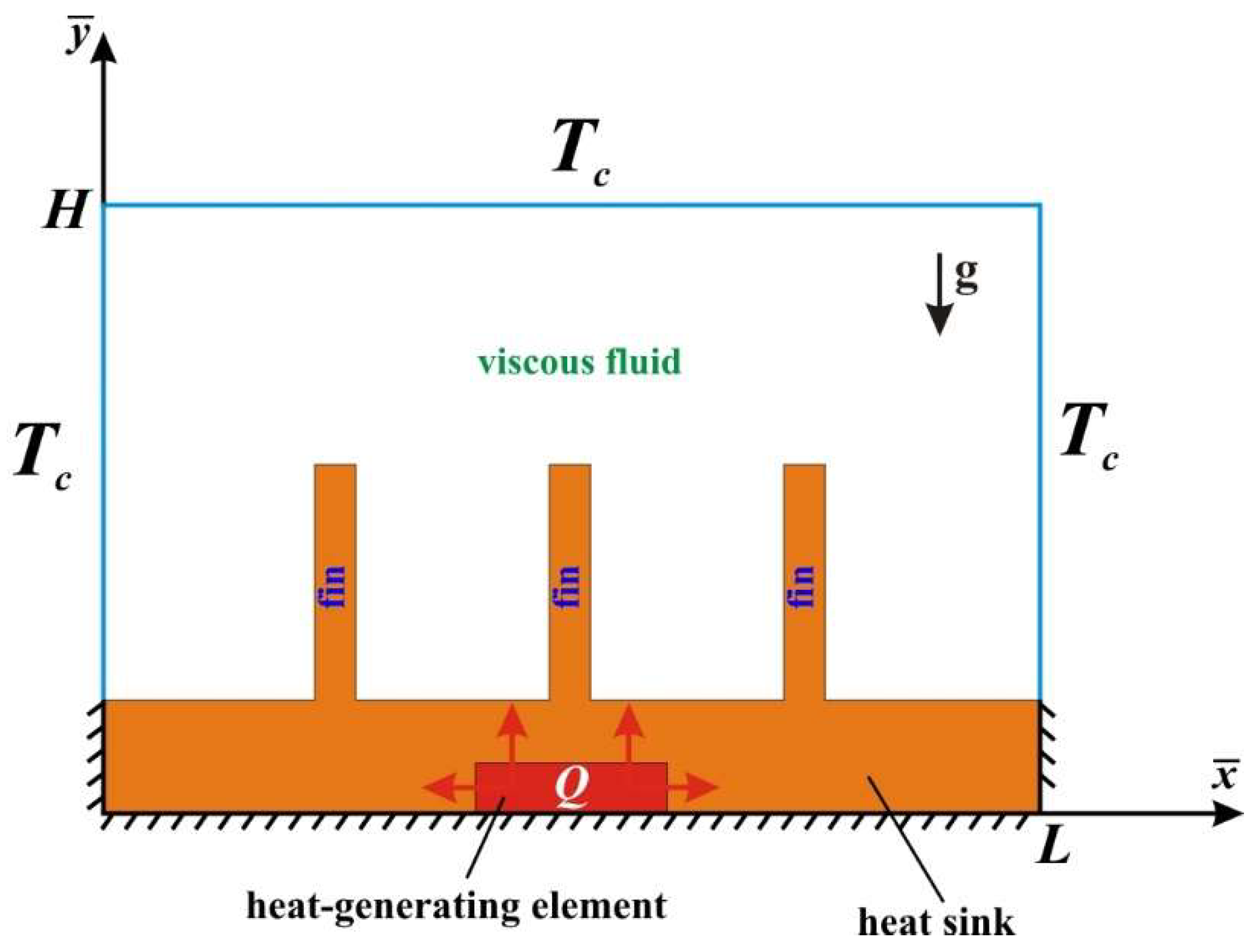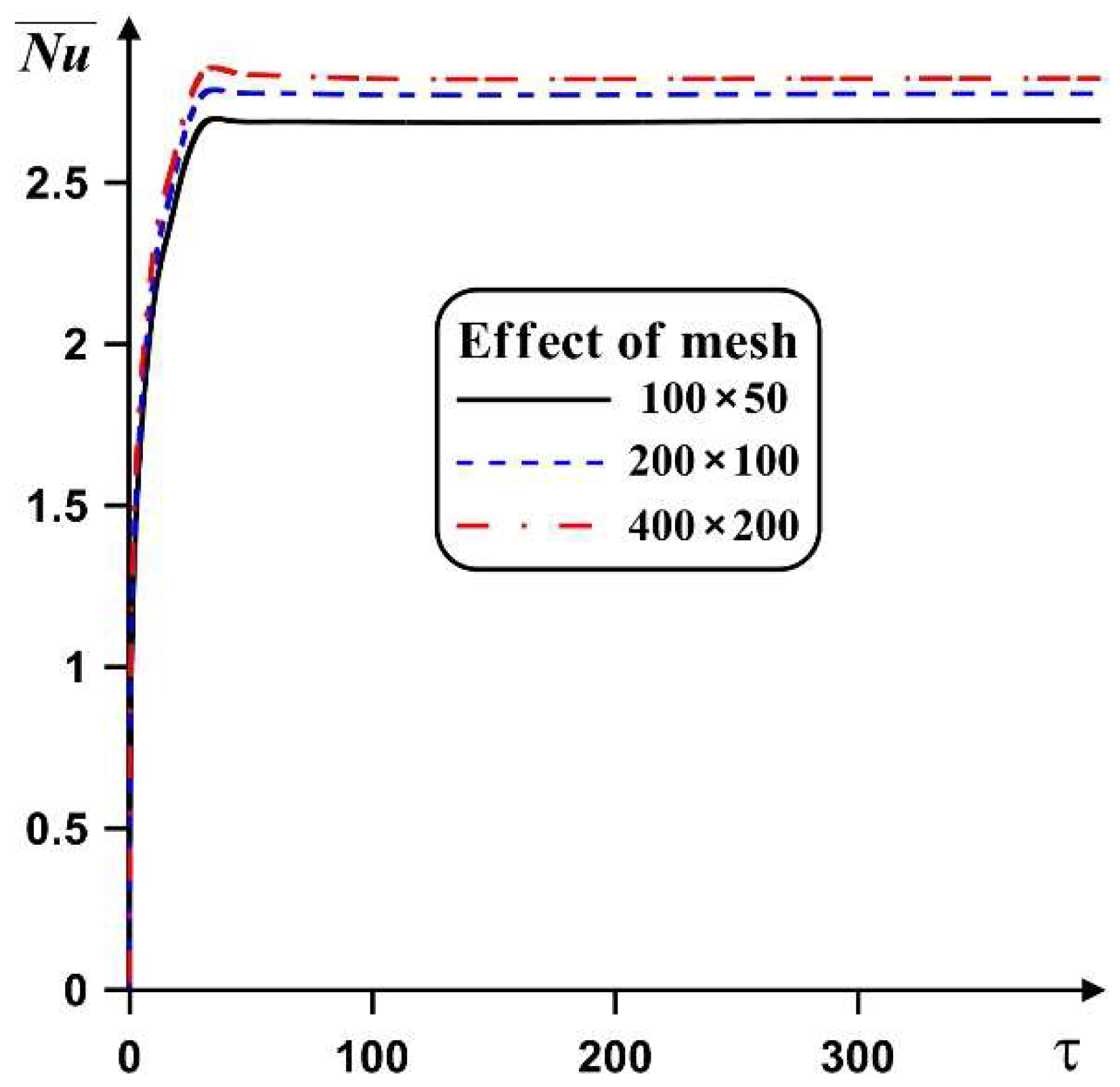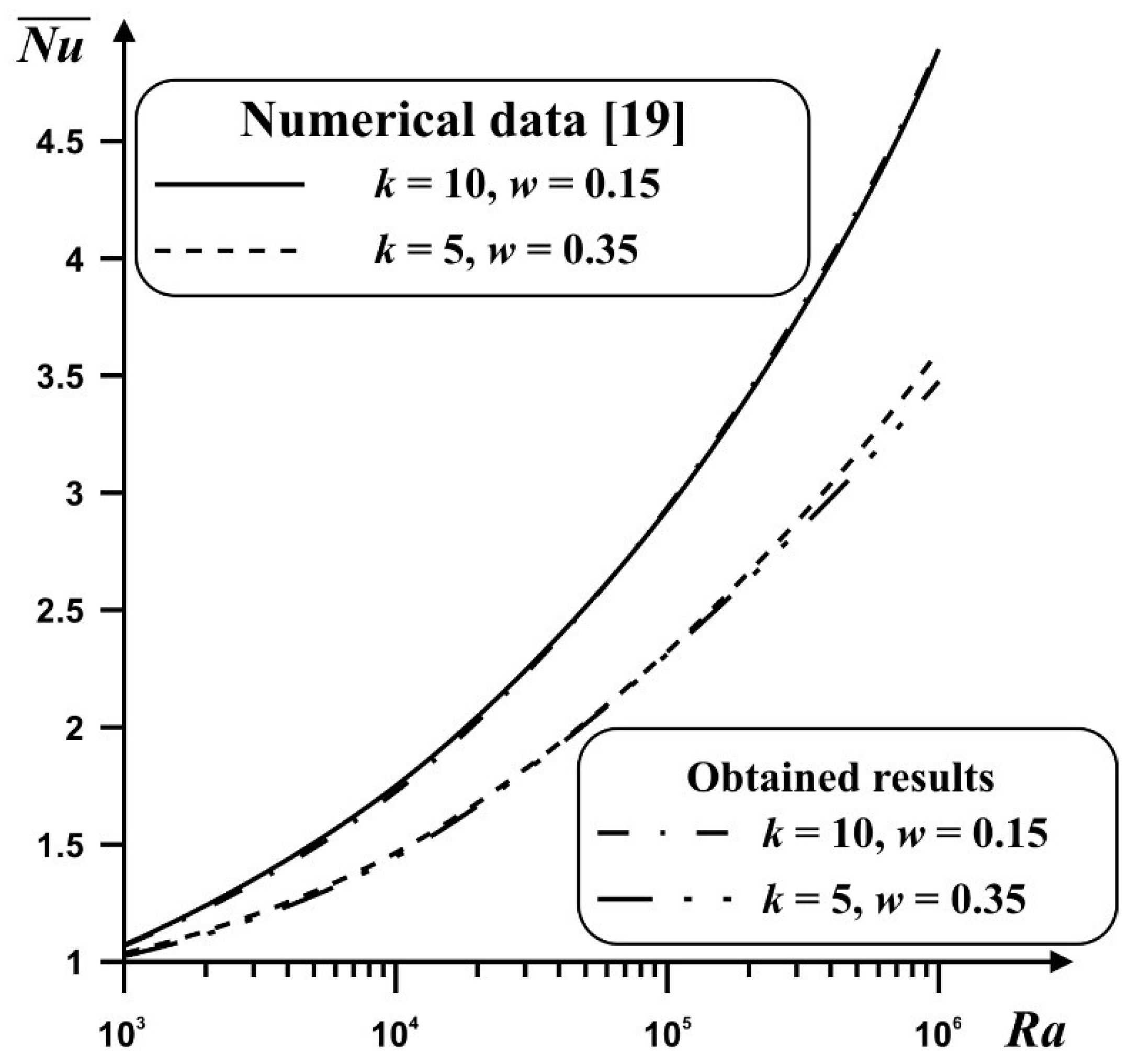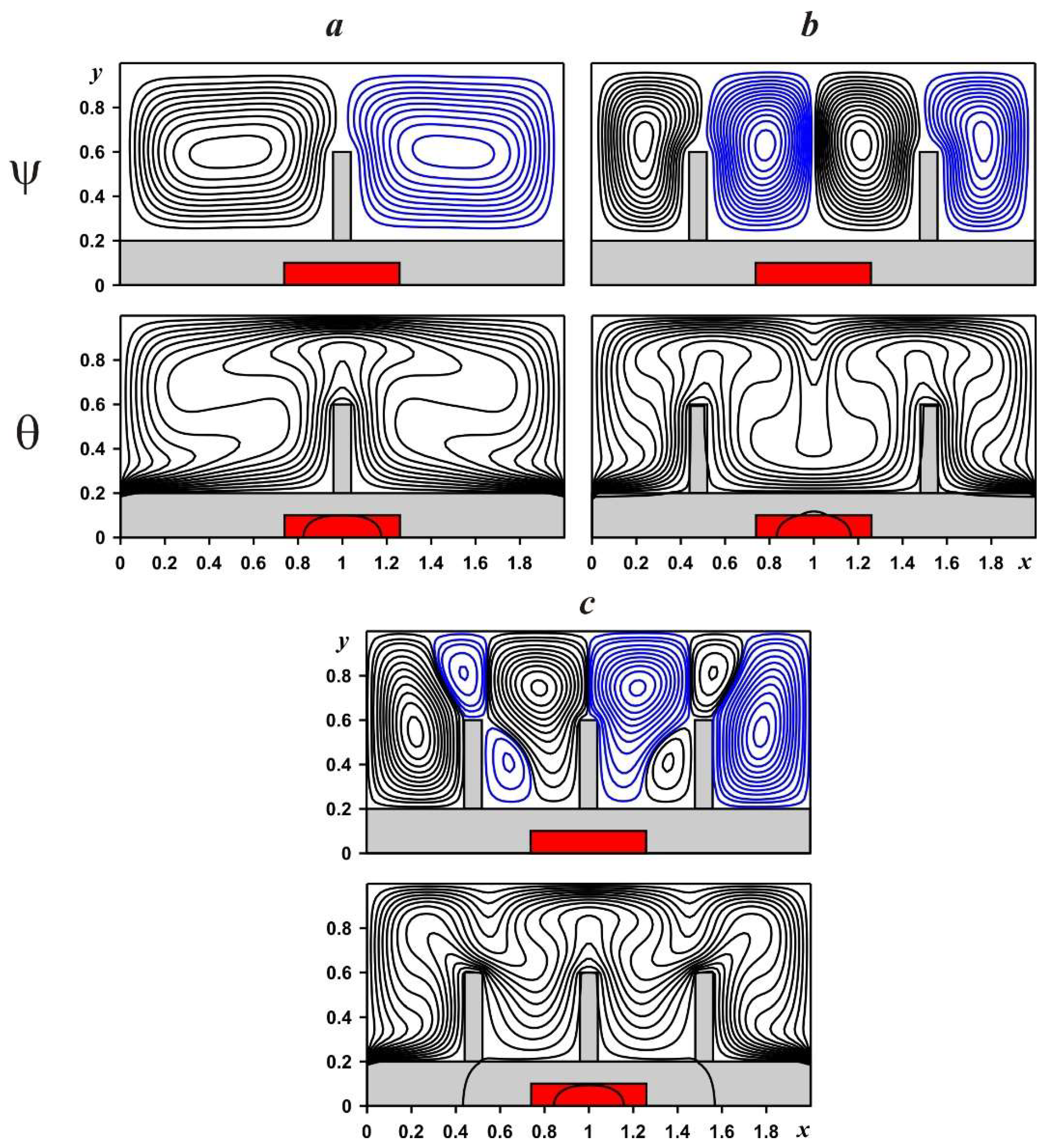Thermogravitational Convective Flow and Energy Transport in an Electronic Cabinet with a Heat-Generating Element and Solid/Porous Finned Heat Sink
Abstract
:1. Introduction
2. Mathematical Simulation
- –
- For the viscous fluid
- –
- For the solid fins and solid heat sink
- –
- For the heat-generating element
- –
- For the porous fins
- –
- For the viscous fluid
- –
- For the solid fins and solid heat sink
- –
- For the heat-generating element
- –
- For the porous fins
3. Solution Technique
4. Results and Discussion
5. Conclusions
- –
- An addition of fins changes the motion structure and energy transfer. In the case of solid material of fins, a growth of the fins number results to a complication of flow structure, while for the porous foam flow nature can be simplified due to the permeability of the fins;
- –
- A growth of the fins height illustrates more essential average heater temperature reduction for the solid fins, while in the case of porous fins, such influence can be reversed;
- –
- An increase in the fins number characterizes a non-monotonic influence on the mean heater temperature. Namely, more essential cooling of the heater occurs in the case of two fins.
Author Contributions
Funding
Institutional Review Board Statement
Informed Consent Statement
Data Availability Statement
Conflicts of Interest
Nomenclature
| c | heat capacity |
| Da | Darcy number |
| g | acceleration due to gravity |
| h | height of the bottom solid plate |
| H | electronic cabinet height |
| k | thermal conductivity |
| K | porous medium permeability |
| L | electronic cabinet length |
| N | fins number |
| Nu | Nusselt number |
| p | pressure |
| Pr | Prandtl number |
| Q | volumetric heat generation density |
| Ra | Rayleigh number |
| t | time |
| T | temperature |
| Tc | cooled wall temperature |
| , | velocity components |
| u, v | non-dimensional velocity components |
| , | Cartesian coordinates |
| x, y | non-dimensional Cartesian coordinates |
| Greek symbols | |
| α | thermal diffusivity |
| β | thermal expansion parameter |
| δ | non-dimensional fins height |
| ε | porous medium porosity |
| θ | non-dimensional temperature |
| μ | dynamic viscosity |
| ρ | density |
| τ | non-dimensional time |
| stream function | |
| ψ | non-dimensional stream function |
| vorticity | |
| ω | non-dimensional vorticity |
| Subscripts | |
| f | fluid |
| hs | heat source |
| pm | porous medium |
| s | solid |
| spm | solid matrix of porous medium |
References
- Nguyen, D.H.; Ahn, H.S. A comprehensive review on micro/nanoscale surface modification techniques for heat transfer enhancement in heat exchanger. Int. J. Heat Mass Transf. 2021, 178, 121601. [Google Scholar] [CrossRef]
- Mousa, M.H.; Miljkovic, N.; Nawaz, K. Review of heat transfer enhancement techniques for single phase flows. Renew. Sustain. Energy Rev. 2021, 137, 110566. [Google Scholar] [CrossRef]
- Bondareva, N.S.; Sheremet, M.A. Conjugate heat transfer in the PCM-based heat storage system with finned copper profile: Application in electronics cooling. Int. J. Heat Mass Transf. 2018, 124, 1275–1284. [Google Scholar] [CrossRef]
- Asl, K.A.; Hossainpour, S.; Rashidi, M.M.; Sheremet, M.A.; Yang, Z. Comprehensive investigation of solid and porous fins influence on natural convection in an inclined rectangular enclosure. Int. J. Heat Mass Transf. 2019, 133, 729–744. [Google Scholar]
- Buonomo, B.; Cascetta, F.; Manca, O.; Sheremet, M. Heat transfer analysis of rectangular porous fins in local thermal non-equilibrium model. Appl. Therm. Eng. 2021, 195, 117237. [Google Scholar] [CrossRef]
- Hatami, M. Numerical study of nanofluids natural convection in a rectangular cavity including heated fins. J. Mol. Liq. 2017, 233, 1–8. [Google Scholar] [CrossRef]
- Siavashi, M.; Yousofvand, R.; Rezanejad, S. Nanofluid and porous fins effect on natural convection and entropy generation of flow inside a cavity. Adv. Powder Technol. 2018, 29, 142–156. [Google Scholar] [CrossRef]
- Hejri, S.; Malekshah, E.H. Cooling of an electronic processor based on numerical analysis on natural convection and entropy production over a dissipating fin equipped with copper oxide/water nanofluid with Koo-Kleinstreuer-Li model. Therm. Sci. Eng. Prog. 2021, 23, 100916. [Google Scholar] [CrossRef]
- Massoudi, M.D.; Hamida, M.B.B.; Almeshaal, M.A.; Hajlaoui, K. The influence of multiple fins arrangement cases on heat sink efficiency of MHD MWCNT-water nanofluid within tilted T-shaped cavity packed with trapezoidal fins considering thermal emission impact. Int. Commun. Heat Mass Transf. 2021, 126, 105468. [Google Scholar] [CrossRef]
- Astanina, M.S.; Rashidi, M.M.; Sheremet, M.A.; Lorenzini, G. Cooling system with porous finned heat sink for heat-generating element. Transp. Porous Media 2020, 133, 459–478. [Google Scholar] [CrossRef]
- Yan, S.R.; Pordanjani, A.H.; Aghakhani, S.; Goldanlou, A.S.; Afrand, M. Managment of natural convection of nanofluids inside a square enclosure by different nano powder shapes in presence of Fins with different shapes and magnetic field effect. Adv. Powder Technol. 2020, 31, 2759–2777. [Google Scholar] [CrossRef]
- Gireesha, B.J.; Sowmya, G.; Khan, M.I.; Oztop, H.F. Flow of hybrid nanofluid across a permeable longitudinal moving fin along with thermal radiation and natural convection. Comput. Methods Programs Biomed. 2020, 185, 105166. [Google Scholar] [CrossRef] [PubMed]
- Esfe, M.H.; Barzegarian, R.; Bahiraei, M. A 3D numerical study on natural convection flow of nanofluid inside a cubical cavity equipped with porous fins using two-phase mixture model. Adv. Powder Technol. 2020, 31, 2480–2492. [Google Scholar] [CrossRef]
- Kumar, D.S.; Jayavel, S. Optimization of porous fin location and investigation of porosity and permeability effects on hydro-thermal behavior of rectangular microchannel heat sink. Int. Commun. Heat Mass Transf. 2021, 129, 105737. [Google Scholar] [CrossRef]
- Ahmad, I.; Ilyas, H.; Raja, M.A.Z.; Khan, Z.; Shoaib, M. Stochastic numerical computing with Levenberg-Marquardt backpropagation for performance analysis of heat Sink of functionally graded material of the porous fin. Surf. Interfaces 2021, 26, 101403. [Google Scholar] [CrossRef]
- Tu, J.; Qi, C.; Tang, Z.; Tian, Z.; Chen, L. Experimental study on the influence of bionic channel structure and nanofluids on power generation characteristics of waste heat utilisation equipment. Appl. Therm. Eng. 2022, 202, 117893. [Google Scholar] [CrossRef]
- Tu, J.; Qi, C.; Li, K.; Tang, Z. Numerical analysis of flow and heat characteristic around micro-ribbed tube in heat exchanger system. Powder Technol. 2022, 395, 562–583. [Google Scholar] [CrossRef]
- Tang, J.; Qi, C.; Ding, Z.; Afrand, M.; Yan, Y. Thermo-hydraulic performance of nanofluids in a bionic heat sink. Int. Commun. Heat Mass Transf. 2021, 127, 105492. [Google Scholar] [CrossRef]
- Yedder, R.B.; Bilgen, E. Laminar natural convection in inclined enclosures bounded by a solid wall. Heat Mass Transf. 1997, 32, 455–462. [Google Scholar] [CrossRef]
- Singh, A.K.; Thorpe, G.R. Natural convection in a confined fluid overlying a porous layer—A comparison study of different models. Indian J. Pure Appl. Math. 1995, 26, 81–95. [Google Scholar]
- Nield, D.A.; Bejan, A. Convection in Porous Media; Springer: New York, NY, USA, 2006. [Google Scholar]







Publisher’s Note: MDPI stays neutral with regard to jurisdictional claims in published maps and institutional affiliations. |
© 2021 by the authors. Licensee MDPI, Basel, Switzerland. This article is an open access article distributed under the terms and conditions of the Creative Commons Attribution (CC BY) license (https://creativecommons.org/licenses/by/4.0/).
Share and Cite
Le, X.H.K.; Pop, I.; Sheremet, M.A. Thermogravitational Convective Flow and Energy Transport in an Electronic Cabinet with a Heat-Generating Element and Solid/Porous Finned Heat Sink. Mathematics 2022, 10, 34. https://doi.org/10.3390/math10010034
Le XHK, Pop I, Sheremet MA. Thermogravitational Convective Flow and Energy Transport in an Electronic Cabinet with a Heat-Generating Element and Solid/Porous Finned Heat Sink. Mathematics. 2022; 10(1):34. https://doi.org/10.3390/math10010034
Chicago/Turabian StyleLe, Xuan Hoang Khoa, Ioan Pop, and Mikhail A. Sheremet. 2022. "Thermogravitational Convective Flow and Energy Transport in an Electronic Cabinet with a Heat-Generating Element and Solid/Porous Finned Heat Sink" Mathematics 10, no. 1: 34. https://doi.org/10.3390/math10010034




